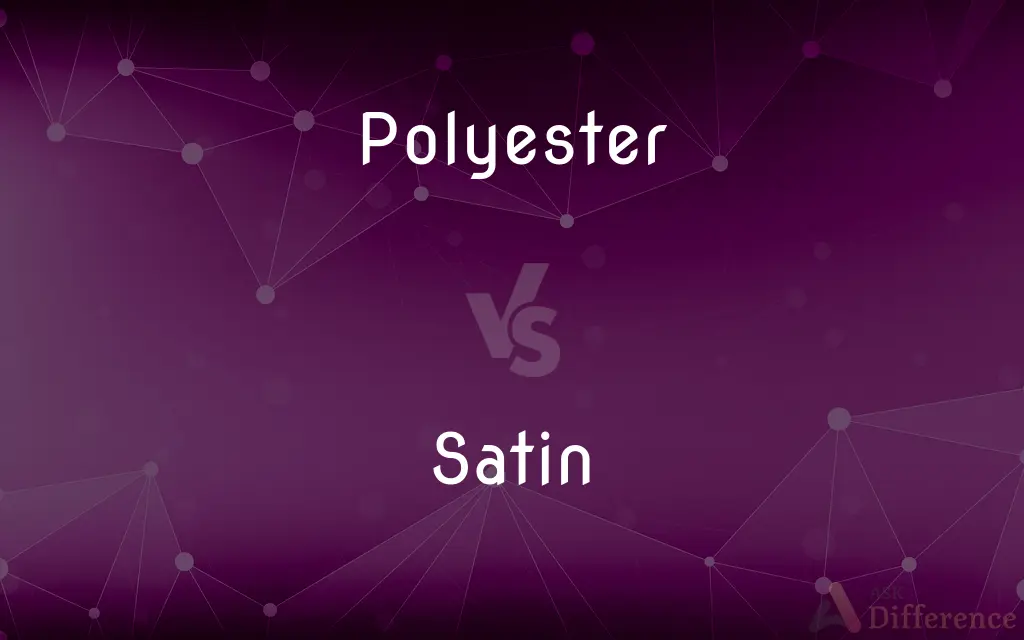Polyester vs. Satin — What's the Difference?
Edited by Tayyaba Rehman — By Fiza Rafique — Updated on September 30, 2023
"Polyester" is a synthetic polymer used as a fabric material. "Satin" is a weave producing a smooth, glossy surface. While polyester can be used to make satin, not all satin is polyester.

Difference Between Polyester and Satin
Table of Contents
ADVERTISEMENT
Key Differences
"Polyester" and "satin" refer to distinct aspects of textile manufacturing. "Polyester" denotes a type of material, specifically a man-made polymer, whereas "satin" alludes to a particular type of weave that produces a fabric with a glossy front and a dull back. Thus, the primary difference lies in one being a material and the other being a weave technique.
In its core, "polyester" is derived from petrochemicals and has been popular in the fabric industry due to its durability, resistance to moisture, and cost-effectiveness. When talking about garments or textiles, mentioning "polyester" generally refers to the type of fiber used. On the other hand, "satin" highlights the structure and appearance of the fabric. Its unique weave, which minimizes visible stitches, creates its hallmark sheen.
Although distinct, "polyester" and "satin" can be interconnected. Polyester can be, and often is, used to produce satin fabrics. Hence, it's feasible to have a garment made from polyester satin, which would combine the characteristics of both: the sheen of satin and the resilience of polyester.
Nevertheless, it's crucial to remember that satin can also be made from other materials like silk, nylon, or acetate. Therefore, while "satin" defines the texture and appearance, it doesn't necessarily specify the material.
Comparison Chart
Basic Definition
A synthetic polymer used in fabrics.
A weave producing a fabric with a glossy front.
ADVERTISEMENT
Origin
Man-made, derived from petrochemicals.
Can be made from various materials.
Texture/Finish
Depends on how it's woven/knitted.
Smooth and glossy on one side.
Primary Use
Fiber for various fabric types.
Produce fabrics with a shiny surface.
Common Combinations
Can be used to create satin.
Can be made from polyester, silk, or nylon.
Compare with Definitions
Polyester
A fabric known for its strength and longevity.
The polyester curtains lasted for years without fading.
Satin
A fabric characterized by its glossy surface.
Her satin dress shimmered under the party lights.
Polyester
A synthetic, durable fiber used in textiles.
She bought a jacket made entirely of polyester.
Satin
Material often chosen for formal attire.
He wore a satin tie to the black-tie event.
Polyester
A versatile material used in clothing and home textiles.
She prefers polyester bedsheets because they dry quickly.
Satin
A weave technique producing a smooth finish.
The satin weave gave the fabric a luxurious feel.
Polyester
Polyester is a category of polymers that contain the ester functional group in every repeat unit of their main chain. As a specific material, it most commonly refers to a type called polyethylene terephthalate (PET).
Satin
A textile known for its silky appearance.
Satin gloves added elegance to her ensemble.
Polyester
A synthetic resin in which the polymer units are linked by ester groups, used chiefly to make synthetic textile fibres.
Satin
A fabric with a shiny front and matte back.
She chose satin for its reflective quality.
Polyester
Any of numerous synthetic polymers produced chiefly by reaction of dicarboxylic acids with dihydric alcohols and used primarily as light, strong, weather-resistant resins in boat hulls, textile fibers, adhesives, and molded parts.
Satin
A satin weave is a type of fabric weave that produces a characteristically glossy, smooth or lustrous material, typically with a glossy top surface and a dull back. It is one of three fundamental types of textile weaves alongside plain weave and twill weave.
Polyester
A wrinkle-resistant fabric of fibers made from any of these resins.
Satin
A smooth, often silk fabric that is woven with a glossy face and a dull back.
Polyester
Any polymer whose monomers are linked together by ester bonds
Satin
A garment made of this fabric.
Polyester
A material or fabric made from polyester polymer
Satin
A kind of paint that dries to a smooth shiny finish.
Polyester
Of, or consisting of polyesters
Satin
Made of or covered with satin.
Polyester
Any of numerous synthetic resins; they are light and strong and weather resistant
Satin
Glossy, sleek, and smooth.
Polyester
A complex ester used for making fibers or resins or plastics or as a plasticizer
Satin
A cloth woven from silk, nylon or polyester with a glossy surface and a dull back. (The same weaving technique applied to cotton produces cloth termed sateen).
Polyester
Any of a large class of synthetic fabrics
Satin
Semigloss.
Satin paint
Polyester
A material resistant to wrinkles and moisture.
The polyester shirt retained its shape after washing.
Satin
(transitive) To make (paper, silver, etc.) smooth and glossy like satin.
Polyester
A widely-used polymer in the fashion industry.
Polyester has become a staple in affordable fashion.
Satin
A silk cloth, of a thick, close texture, and overshot woof, which has a glossy surface.
Cloths of gold and satins rich of hue.
Satin
A smooth fabric of silk or rayon; has a glossy face and a dull back
Common Curiosities
What is Polyester made of?
Polyester is a synthetic material derived from petrochemicals.
Is Satin always made from Polyester?
No, satin can be made from various materials, including silk and nylon.
Is Satin suitable for summer wear?
Satin, especially when made from synthetic fibers, can be less breathable, making it less suitable for hot conditions.
Why do formal gowns often use Satin?
Satin's glossy finish gives a luxurious and elegant appearance, suitable for formal attire.
How can you describe the texture of Satin?
Satin has a smooth, glossy front and a matte back.
Is Polyester environmentally friendly?
Polyester is less biodegradable than natural fibers, raising environmental concerns.
Why is Polyester popular in clothing?
Polyester is durable, resistant to moisture, and cost-effective.
Can Polyester be blended with other materials?
Yes, polyester is often blended with cotton and other fibers to combine properties.
How do you care for Polyester garments?
Polyester garments can typically be machine washed and dried but always check care labels.
Can Satin be used for bedding?
Yes, satin sheets are popular for their smooth, cool feel.
Does Polyester dye easily?
Polyester requires specific dyes and can be harder to dye than natural fibers.
What are common uses for Polyester outside of clothing?
Polyester is used in upholstery, curtains, and various home textiles.
Are there different types of Satin?
Yes, variations like Duchesse satin or charmeuse differ in weight and sheen.
Is Satin weave the same as Sateen weave?
No, while both have a glossy finish, satin is woven from filament fibers, while sateen is from spun yarns.
How does Polyester react to heat?
Polyester can melt or shrink when exposed to high heat, so low-temperature ironing and drying are recommended.
Share Your Discovery

Previous Comparison
Geisha vs. Geish
Next Comparison
Fortepiano vs. PianoAuthor Spotlight
Written by
Fiza RafiqueFiza Rafique is a skilled content writer at AskDifference.com, where she meticulously refines and enhances written pieces. Drawing from her vast editorial expertise, Fiza ensures clarity, accuracy, and precision in every article. Passionate about language, she continually seeks to elevate the quality of content for readers worldwide.
Edited by
Tayyaba RehmanTayyaba Rehman is a distinguished writer, currently serving as a primary contributor to askdifference.com. As a researcher in semantics and etymology, Tayyaba's passion for the complexity of languages and their distinctions has found a perfect home on the platform. Tayyaba delves into the intricacies of language, distinguishing between commonly confused words and phrases, thereby providing clarity for readers worldwide.














































